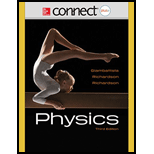
Concept explainers
(a)
Identify the direction of propagation of wave.
(a)
Answer to Problem 38P
Wave propagates in left direction.
Explanation of Solution
Speed of transverse wave is
The direction of wave is determined by whether the argument of cosine function is positive or not. If it is positive, means that the wave is propagating in left direction and negative value indicates the propagation in right direction. For the wave
Therefore, the wave propagates in left direction.
(b)
The numerical values of
(b)
Answer to Problem 38P
Explanation of Solution
Speed of transverse wave is
Amplitude is the maximum displacement from the mean position. It can be found directly from the diagram.
Write the value of amplitude.
Write the equation to find the angular frequency.
Here,
Wavelength is the distance from beginning of a crest to the end of adjacent trough. From the graph it is found that the wavelength is
Write the equation to find the wave number.
Here,
Conclusion:
Substitute
Substitute
Therefore,
(c)
Identify the instants (three smallest non negative cases) at which the snap of wave is taken.
(c)
Answer to Problem 38P
The snap is shot at
Explanation of Solution
Speed of transverse wave is
Time of snap shot can be identified from the instants at which maximum displacement occurs.
Write the value of cosine function at the time of maximum displacement.
Write the possible values for
Here,
Rewrite the above relation in terms of
It is seen that there is a peak at
Rewrite equation (I) by multiplying with
Substitute
Rewrite equation (II) by substituting the above value of
Write the relation between the time period and
Here,
Rewrite the previous equation for
Write the relation between
Conclusion:
Substitute
Substitute
Substitute
Substitute
Therefore, the snap is shot at
Want to see more full solutions like this?
Chapter 11 Solutions
Physics - Connect Access (2 Semester)
 College PhysicsPhysicsISBN:9781305952300Author:Raymond A. Serway, Chris VuillePublisher:Cengage Learning
College PhysicsPhysicsISBN:9781305952300Author:Raymond A. Serway, Chris VuillePublisher:Cengage Learning University Physics (14th Edition)PhysicsISBN:9780133969290Author:Hugh D. Young, Roger A. FreedmanPublisher:PEARSON
University Physics (14th Edition)PhysicsISBN:9780133969290Author:Hugh D. Young, Roger A. FreedmanPublisher:PEARSON Introduction To Quantum MechanicsPhysicsISBN:9781107189638Author:Griffiths, David J., Schroeter, Darrell F.Publisher:Cambridge University Press
Introduction To Quantum MechanicsPhysicsISBN:9781107189638Author:Griffiths, David J., Schroeter, Darrell F.Publisher:Cambridge University Press Physics for Scientists and EngineersPhysicsISBN:9781337553278Author:Raymond A. Serway, John W. JewettPublisher:Cengage Learning
Physics for Scientists and EngineersPhysicsISBN:9781337553278Author:Raymond A. Serway, John W. JewettPublisher:Cengage Learning Lecture- Tutorials for Introductory AstronomyPhysicsISBN:9780321820464Author:Edward E. Prather, Tim P. Slater, Jeff P. Adams, Gina BrissendenPublisher:Addison-Wesley
Lecture- Tutorials for Introductory AstronomyPhysicsISBN:9780321820464Author:Edward E. Prather, Tim P. Slater, Jeff P. Adams, Gina BrissendenPublisher:Addison-Wesley College Physics: A Strategic Approach (4th Editio...PhysicsISBN:9780134609034Author:Randall D. Knight (Professor Emeritus), Brian Jones, Stuart FieldPublisher:PEARSON
College Physics: A Strategic Approach (4th Editio...PhysicsISBN:9780134609034Author:Randall D. Knight (Professor Emeritus), Brian Jones, Stuart FieldPublisher:PEARSON





